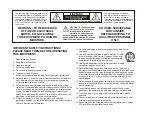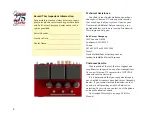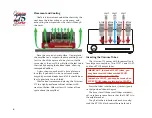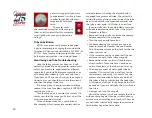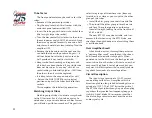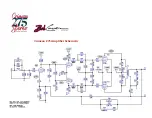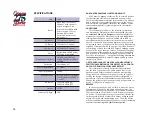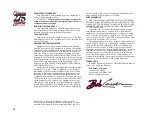
10
your starting point if you want
to experiment. It will vary from
speaker to speaker, and most
importantly with your
taste.
The meter reads
the combined current for all four output
tubes, and it is normal for this current to
vary slightly with changes in power line
voltage.
Tube Substitution
KT120s are not your only output tube option,
if you’re interesting in changing the sound of the
Crimson 275. You can substitute 6L6, 6550, KT88, or
KT120’s. But of course, all four output tubes must
be the same designation — no mixing allowed!
Monitoring and Tube Troubleshooting.
Once the idling current has been set, it will
normally not need to be adjusted for several years
unless you want to
)a
experiment for different
sound;
b)
if you install different output tubes, or
c)
the amplifier suddenly starts to sound funny.
If you hear a POP and see a flash, yet the amp con-
tinues to play, you should first check the current
and then the output tube fuse.
If the fuse blows, the output current will drop
to zero. If the tube fuse blows, replace it WITHOUT
replacing any tubes.
Turn the amp on and monitor the current. If it
climbs to within the range you had set, and if the
amp sounds good, all is well.
Often, an output tube has a speck of dust-
like impurity, which comes into contact with an
internal element, shorting the element, and is
vaporized into gaseous oblivion. The getter, the
mirror-like shiny plating on the inside of the tube
does its job, absorbs the vaporized material and
the tube is new again. All it takes is a new fuse.
If you install a new fuse and it blows again, you
will need to determine which tube is the culprit.
Proceed as follows:
• Remove all output tubes and turn the preamp
volume control all the way down.
• Turn the amp on and leave it on.
• While monitoring the current, put a pair of
tubes into sockets Number One and Number
Two. Allow one minute on the clock for the two
tubes to warm up.
• If the current comes up to about half the nor-
mal amount, both those tubes are good.
• Remove those tubes and install another pair,
also in sockets Three and Four. Continue on
until a fuse blows, or the tubes won’t bias up.
• Then buy or borrow a known good tube (re-
member, if it is actually bad, we’ll pay for the
replacement), and using it as a mate, use the
process of elimination to figure out which of
the tubes is bad by substituting the good tube.
At this point, if you get lucky, only one trial will
be needed. If you are not lucky, then it will take
two trials.
• Now you can turn the amp off.
You will be able to install and remove the tubes
with your bare fingers if you do it within about a
minute or so of installing each fresh set. That’s be-
cause it takes substantially longer than a minute
for the tubes to get too hot to hold.
Summary of Contents for 27813
Page 1: ...Operating Manual c02 15 19...


